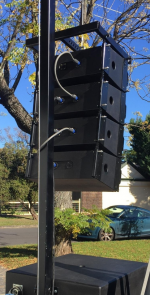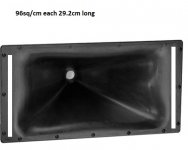There was a Finnish study from 2008 that came to the same conclusions. Very little to no differences were heard on a variety of sound sources. As long as you keep the slopes to 48db per octave or lower you should be fine.
My own experiences found it possible to hear small differences but not necessarily better. And that was only with minimally processed recordings. Sounds like the magic of synergy horns has little to do with linear phase.
My own experiences found it possible to hear small differences but not necessarily better. And that was only with minimally processed recordings. Sounds like the magic of synergy horns has little to do with linear phase.
Good so there's no reason for me to fork out some cash on expensive DSP amps with FIR filters.
Back to my idea of building a SynTripP on steroids - would using a BMS 4594HE coaxial CD crossed at 500-600hz and then using 12" or even 15" woofers be a good idea? Obviously the larger woofers cannot be mounted as close to the throat but the lower crossover point allowed by the coaxial CD would mitigate this. The coaxial CD seems like a good way to avoid having to build a 3-way synergy whilst still retaining high SPL (126-130dB continuous).
I realise that the low end is still the weakest link but I could tune the bass reflex ports a little higher (90-100hz).
Back to my idea of building a SynTripP on steroids - would using a BMS 4594HE coaxial CD crossed at 500-600hz and then using 12" or even 15" woofers be a good idea? Obviously the larger woofers cannot be mounted as close to the throat but the lower crossover point allowed by the coaxial CD would mitigate this. The coaxial CD seems like a good way to avoid having to build a 3-way synergy whilst still retaining high SPL (126-130dB continuous).
I realise that the low end is still the weakest link but I could tune the bass reflex ports a little higher (90-100hz).
Last edited:
The Celestion Axi2050 looks interesting as well and would simplify the design requirements.
Last edited:
There is a topic somewhere about that driver. Seems half the price of BMS. but it's an OEM driver. Patrick did some research on it. (great find)
Not as good as Peter Morris idea 😉Back to my idea of building a SynTripP on steroids - would using a BMS 4594HE coaxial CD crossed at 500-600hz and then using 12" or even 15" woofers be a good idea?
New DIY Mid High | Sound Forums
Art,
Looking at peter Morris design I may be wrong but it reminds me of the big western electric horns driven by compression drivers but full of honk/Homs due to uneven flare rate ( spl power maybe) but sound wise ??
I can’t see anything beating the original unity,synergy flare rate design regards dare I say it hifi sound, syntripp included
Thoughts
Looking at peter Morris design I may be wrong but it reminds me of the big western electric horns driven by compression drivers but full of honk/Homs due to uneven flare rate ( spl power maybe) but sound wise ??
I can’t see anything beating the original unity,synergy flare rate design regards dare I say it hifi sound, syntripp included
Thoughts
Charlie,
The SynTripP sounds quite good, costs and weighs far less than Peter Morris' design, but from the measurements I've seen (and done) it wouldn't keep up to his design in an A/B test, especially if volume is considered, it's in another class.
Welterweights don't fight heavyweights .
.
The BMS 4594HE on a RCF HF950 has measurably better polar response than the SynTripP or any of the basic "Keele break" straight sided two-part conical horn designs. It also appears to be measurably smoother, requiring less equalization to remove peaks and dips.
The slightly "pinched" throat does cause some diffraction issues, but that goes with the territory of wide dispersion and a 2" throat. The smooth transitions employed in the RCF HF950's flares are a far cry from the hard chines on the original constant directivity horns of the mid-1970's, a practice that still continues on many designs today to reduce costs.
Even Earl's OS waveguides are not "HOMless", or he wouldn't stuff them with "antiHOM foam" 😉.
Conical horns are easy to build and have a reasonably good approximation of constant directivity, but are not the last word in "high fidelity".
Art
The SynTripP sounds quite good, costs and weighs far less than Peter Morris' design, but from the measurements I've seen (and done) it wouldn't keep up to his design in an A/B test, especially if volume is considered, it's in another class.
Welterweights don't fight heavyweights
 .
.The BMS 4594HE on a RCF HF950 has measurably better polar response than the SynTripP or any of the basic "Keele break" straight sided two-part conical horn designs. It also appears to be measurably smoother, requiring less equalization to remove peaks and dips.
The slightly "pinched" throat does cause some diffraction issues, but that goes with the territory of wide dispersion and a 2" throat. The smooth transitions employed in the RCF HF950's flares are a far cry from the hard chines on the original constant directivity horns of the mid-1970's, a practice that still continues on many designs today to reduce costs.
Even Earl's OS waveguides are not "HOMless", or he wouldn't stuff them with "antiHOM foam" 😉.
Conical horns are easy to build and have a reasonably good approximation of constant directivity, but are not the last word in "high fidelity".
Art
Hi Art. You have inspired me to work out a bit of a no holds barred High-end audio version of this. A two way that is capable of launching a spherical wavefront. Should have it up and running by the end of April. As you have alluded to. There are always compromises. It's the ones that matter in the correct environment. And the correct application.
It's what makes engineering a true art. If it were easy everybody would be doing it!
It's what makes engineering a true art. If it were easy everybody would be doing it!
I have tried to explore every option of increasing the bass output of the SynTripP as I was hoping to keep it as a synergy horn but you are right, nothing can touch the Peter Morris DIY for the size and weight. After reading reviews of how clean and coherent it sounds I have decided to pursue building a pair of Peter Morris' DIY 90.
With the cabinet weight and output, you will want to get it way over head height, also consider buying or building lifts.After reading reviews of how clean and coherent it sounds I have decided to pursue building a pair of Peter Morris' DIY 90.
Peter also has a good design for that:
Attachments
Sergey,
The location of bass reflex ports as depicted in white on the sides of the JBL 2384 would have little effect on it's polar response.
Art
The location of bass reflex ports as depicted in white on the sides of the JBL 2384 would have little effect on it's polar response.
Art
Think I'm going to give building the SynTripP a go. Going to build 1 to try it out. I have read through the build thread a few times. Before I order, can I confirm the Eminence N314T and B&C10cl51 are a tried a true combo in this build?
Thank you.
Thank you.
Pyrosound,
The SynTripP was designed using B&C10CL51 cones and the Celestion CDX14-3050 compression driver.
The Eminence N314T has been suggested as an alternative to the CDX14-3050, but have not heard any "tried and true" reports back.
Art
The SynTripP was designed using B&C10CL51 cones and the Celestion CDX14-3050 compression driver.
The Eminence N314T has been suggested as an alternative to the CDX14-3050, but have not heard any "tried and true" reports back.
Art
Thank you for the reply Art. I'll do a little more research and try to get a better understanding before making a decision.
Can we see this on facebook?
Footage from hosting 3000 people on our mobile artcar. Two main SynTripPs running somewhere near RMS, and two for filling in front at -10db.
Bass provided by two XOC1 TH118 with B&C 18SW115.
pink opening - Robert Chan Photography
Are you sure this is 3000 people with 4 Syntripps and 2 TH118? Was the bass adequate? I want to use your setup this as a guideline.
I want to build 4 x ROAR 15 with Beyma 15G450 for subs, and probably 2 x Peter Morris/Synergy/Syntripps for 3000 people.
It is easy to do a SOD (Static Crowd Density) based on the square meter (m2) of terrain your have available. Before the crowd comes in you measure your area in m2 and divide it in zones from front to back. We do this for safety purposes. For normal crowd you can calculate about 2 to 4 people per m2. 4 people per m2 is about the limit you want. Let's say you have 200 m2 of terrain available. The crowd limit of 200 m2 is about 800 people (4 per m2) that 200m2 is about 10 meters width and 20 meters long.
To fill 3000 people (4 people per m2) you need about 750m2 of space. that is about 20 meters width and 40 meters long. (65 x 131 foot)
To fill 3000 people (4 people per m2) you need about 750m2 of space. that is about 20 meters width and 40 meters long. (65 x 131 foot)
Last edited:
- Home
- Loudspeakers
- Multi-Way
- SynTripP: 2-way 2-part Virtual Single Point Source Horn

